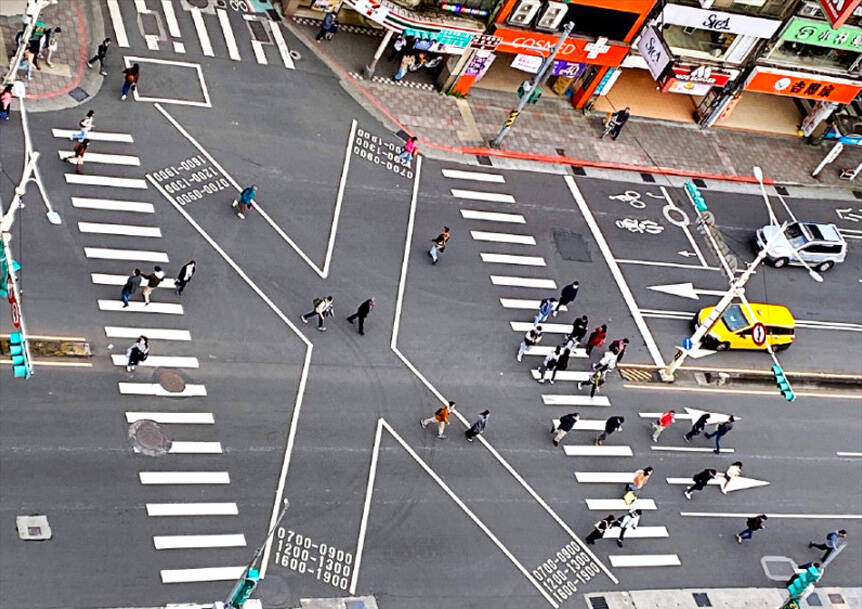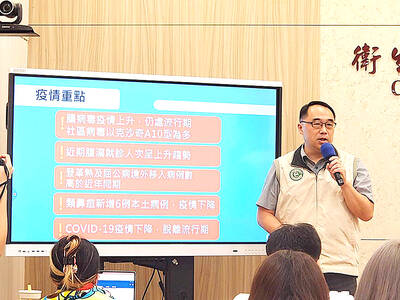Pedestrian scramble crossings and widened sidewalks helped reduce pedestrians’ exposure to PM2.5 by up to 94 and carbon monoxide by up to 11 percent, a report of the Ministry of Transportation and Communications’ Institute of Transportation said.
The institute conducted a study on the influence of vehicle exhaust on pedestrians in relation to different traffic environment characteristics at multiple intersections in Taipei, New Taipei City and Kaohsiung.
The study showed that “pedestrian scrambles,” or exclusive pedestrian intervals, significantly reduced pedestrians’ exposure to air pollutants, especially at intersections with a relatively complex traffic environment, the report said.

Photo: Wu Liang-yi, Taipei Times
As pedestrian scrambles enable people to cross intersections while keeping their distance from vehicles, their exposure to PM2.5 decreased by 94 percent, it said.
At intersections with more large vehicles, carbon monoxide exposure declined by about 11 percent, it said.
To reduce the likelihood of collisions between pedestrians and vehicles, pedestrian scrambles had been set up at 1,316 intersections nationwide as of the end of last year, covering almost all administrative areas, it said.
Similarly, sidewalks that had been widened by 0.5m could reduce pedestrians’ exposure to PM2.5 by nearly 2 percent and carbon monoxide by about 3 percent, the report said.
Other traffic environment characteristics, such as traffic light timing optimization and crosswalk setbacks, were also found helpful in reducing air pollution exposure, although not as significantly as pedestrian scrambles and sidewalk widening, it said.
Data from the Ministry of Environment showed that transportation made up 16 percent of PM2.5 emissions in Taiwan, less only than construction or road dust and industrial exhaust.
The institute’s Transportation Energy and Environment Division chief Chu Pei-yun (朱珮芸) said the study aimed to aid local government policymaking, with more comprehensive guidelines to be handed to local transportation departments after compilation.
Linkou Chang-Gung Memorial Hospital’s Department of Pediatric Allergy, Asthma and Rheumatology doctor Yeh Kuo-wei (葉國偉) said that although vehicle exhaust has various components, PM2.5 has been foregrounded, as it is most harmful to human health.
PM2.5 is made up of tiny particles that can travel into the lower respiratory tract and be deposited in the lungs, so long-term exposure could cause not only bronchitis and allergies, but also serious lung diseases, he said.
Research shows that PM2.5 and carbon monoxide — the main components of fossil fuel vehicle emissions — tends to aggravate asthma in children and chronic obstructive pulmonary disease, cardiovascular diseases and respiratory syndrome in adults, Yeh said.
Other research over the past few years showed that air pollution is one of the causes of many cancers commonly found in Taiwanese, he added.
Multiple studies looking into the correlation between asthma and the environment ministry’s air quality index found that PM2.5 significantly affected adults and children, Yeh said.
PM2.5 is harmful “particularly for children, as they have diminutive figures, breathe faster, and therefore could easily inhale car exhaust emitted underneath,” he added.
Taipei Medical University’s Department of Respiratory Therapy professor Chuang Hsiao-chi (莊校奇) said that aside from PM2.5, sulfides and nitrogen oxides are also air contaminants harmful to humans.
As for carbon monoxide, its concentration is unlikely to be high enough to cause acute physical injuries, given that intersections are open spaces, he said.
However, residents or shop workers on lower floors must be aware of traffic air pollution’s impact on indoor air quality, Chuang said.
People with respiratory tract diseases or allergies can protect themselves by wearing a mask or keeping their distance from cars or motorbikes while walking outside, he said.
Those who exercise are advised to stay away from places with heavy traffic emissions to avoid breathing in too much exhaust while exercising, Chuang added.
Pedestrian scrambles refer to the time interval when vehicle traffic is stopped by a red light and all pedestrians can cross the intersection simultaneously.

A magnitude 4.9 earthquake struck off Tainan at 11:47am today, the Central Weather Administration (CWA) said. The hypocenter was 32.3km northeast of Tainan City Hall at a depth of 7.3km, CWA data showed. The intensity of the quake, which gauges the actual effect of a seismic event, measured 4 in Tainan and Chiayi County on Taiwan's seven-tier intensity scale, the data showed. The quake had an intensity of 3 in Chiayi City and County, and Yunlin County, while it was measured as 2 in Kaohsiung, Nantou County, Changhua County, Taitung County and offshore Penghu County, the data showed. There were no immediate reports of

Weather conditions across Taiwan are expected to remain stable today, but cloudy to rainy skies are expected from tomorrow onward due to increasing moisture in the atmosphere, according to the Central Weather Administration (CWA). Daytime highs today are expected to hit 25-27°C in western Taiwan and 22-24°C in the eastern counties of Yilan, Hualien, and Taitung, data on the CWA website indicated. After sunset, temperatures could drop to 16-17°C in most parts of Taiwan. For tomorrow, precipitation is likely in northern Taiwan as a cloud system moves in from China. Daytime temperatures are expected to hover around 25°C, the CWA said. Starting Monday, areas

The Chinese Nationalist Party (KMT) is maintaining close ties with Beijing, the Democratic Progressive Party (DPP) said yesterday, hours after a new round of Chinese military drills in the Taiwan Strait began. Political parties in a democracy have a responsibility to be loyal to the nation and defend its sovereignty, DPP spokesman Justin Wu (吳崢) told a news conference in Taipei. His comments came hours after Beijing announced via Chinese state media that the Chinese People’s Liberation Army’s Eastern Theater Command was holding large-scale drills simulating a multi-pronged attack on Taiwan. Contrary to the KMT’s claims that it is staunchly anti-communist, KMT Deputy

Taiwan has recorded its first fatal case of Coxsackie B5 enterovirus in 10 years after a one-year-old boy from southern Taiwan died from complications early last month, the Centers for Disease Control (CDC) said yesterday. CDC spokesman Lo Yi-chun (羅一鈞) told a news conference that the child initially developed a fever and respiratory symptoms before experiencing seizures and loss of consciousness. The boy was diagnosed with acute encephalitis and admitted to intensive care, but his condition deteriorated rapidly, and he passed away on the sixth day of illness, Lo said. This also marks Taiwan’s third enterovirus-related death this year and the first severe